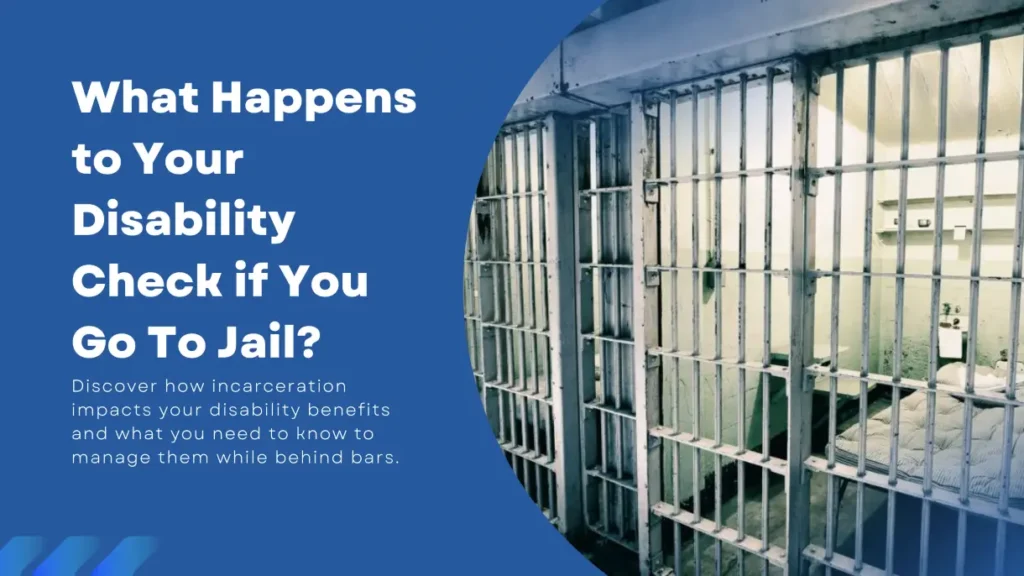Today, we have an interesting question about what happens to your disability check if you go to jail, asked by someone who reached out to us after serving time in prison. His email reads: “I received disability benefits until October 3, 2015. Then I was incarcerated until November 15, 2019. Am I still eligible for disability benefits?” Let’s explore how jail or prison can affect people’s ability to get benefits upon release.
Ready to see if you may qualify? Click here to get a FREE, no-obligation consultation before starting your claim.
What Happens To Your Disability Check If You Go To Jail? Key Takeaways
- Benefits from Social Security Disability Insurance (SSDI) and Supplemental Security Income (SSI) are suspended if you are incarcerated for more than 30 days.
- Once released, SSDI benefits can be restarted one month after your release, upon submitting release documents to the Social Security Administration (SSA).
- For SSI, if incarcerated for over a year, your benefits are terminated and you must reapply and go through the approval process anew.
- Felons remain eligible for SSDI upon release unless the felony involved harming a spouse or parent, or the disability was incurred or exacerbated during the commission of the felony and jail time.
- Consulting a lawyer can simplify the process of reinstating benefits, helping to navigate paperwork and ensuring timely reinstatement of your benefits.
How A Criminal Conviction Affects Your Disability Benefits
The Social Security Administration (SSA) pays disability benefits through two different federal programs. The first one, Social Security Disability Insurance (SSDI), only pays people who worked enough and in recent years to qualify. If SSDI paid your previous benefits, you likely received at least $1,000 each month. The second federal disability program, Supplemental Security Income (SSI), pays no more than $841/month in benefits.
No matter which program pays your benefits, the SSA suspends them once you’re in jail or prison more than 30 days. So, nobody in jail, prison or confined to a criminal institution after conviction can receive SSDI or SSI payments. This federal rule also applies to people living in halfway houses after prison or jail. However, if you’re on parole and living on your own or with family, that’s different. The rule simply says you cannot live in any facility that operates under the Department of Corrections’ authority. Once you finish your sentence and receive an official release, you can potentially re-start your benefits the following month. This includes parolees who must wear an ankle bracelet for home monitoring upon release.
How to Re-Start Your SSDI Benefits After Release From Jail or Prison
If you received SSDI benefits before your arrest, you can re-start them again one month after release from jail or prison. Here’s how to do that:
- Contact the SSA and explain that you’re out on official release.
- Tell them you’d like to restart your SSDI benefits right away.
- Submit a copy of your release documents to your local SSA office. The agency cannot act on your request until they get those documents!
- Depending on how long you wait to request reinstatement, you may qualify for back payments. Once you complete steps 1-3, you may qualify for a lump-sum back payment in addition to monthly SSDI. Your back payment covers all months the SSA owed you SSDI benefits before you contacted them.
- If you cannot get through on the phone, contact a nearby lawyer. We can match you with an attorney in your area who can help you for free today.
The date you receive your first SSDI payment depends on the terms and date of your release. For example: if Your email stated your jail or prison sentence ended on November 15, 2022, That means the SSA owes your your next SSDI benefit payment in December 2022.
Once you’re on SSDI for 24 months, you automatically qualify for Medicare. You likely had Medicare Part A coverage without interruption during your incarceration. But if you didn’t pay your Medicare Part B premiums while in prison or jail, that coverage ended. You can re-apply for Medicare Part B during the next open enrollment period (i.e., January through March). Once you reapply, your Medicare Part B coverage will begin the following July. You can also likely get cheap or no-cost health insurance through a discounted ACA Marketplace plan.
SSI Eligibility Rules for Anyone in Jail or Prison More Than 12 Months
Once you’re in jail or prison for more than a year, the SSA automatically terminates your SSI benefits. That means unlike SSDI, you cannot restart those payments. Instead, you must file a new SSI claim and go through the approval process again. Here’s what you need to know before you begin:
- You cannot re-apply for SSI online through the SSA.gov website. This is because you got SSI benefits before, which disqualifies you.
- The government closed all Social Security offices nationwide in March 2020. That means you cannot visit the closest office to apply for SSI in person. What you can do, however, is enter your ZIP code here and then click “locate.” This is the fastest way to look up your local SSA office’s phone number.
- Call your local SSA office during business hours Monday-Friday and explain your current situation. You can potentially apply for SSI over the phone when you call.
You must still go through the regular SSI claim review and approval process, which can take several months. This is true even if your health issues and financial information are the same as before your arrest. That’s because SSI eligibility automatically ends after 12 months in jail or prison.
Just like SSDI, you must provide your official release documents from the correctional facility. Once approved for SSI, you’ll automatically qualify for Medicaid coverage along with monthly benefits.
Do Felons Get Social Security Benefits?
Felons are still eligible for Social Security benefits when their time in jail comes to an end. If you were already approved for disability benefits prior to their time in prison, you can have your SSDI benefits reinstated, but if you were on SSI, you’ll need to reapply using the rules above.
However, there are a few exceptions to this rule that will disqualify you from SSDI benefits after a felony conviction:
- Your disability arose or was made even worse while you committed your felony
- Your disability arose or was made worse while you were imprisoned in jail
- You made yourself a widow or orphan by killing your spouse or parent (which makes you ineligible for Social Security survivor benefits)
Work With a Lawyer If You Need Help Getting Your Benefits Reinstated
Understanding how to get your disability benefits back after being in jail or prison can be tricky. If you were getting SSDI or SSI before, you need to act quickly once you’re released to make sure you don’t miss out on any benefits you’re owed.
Since this can be a lot to handle, it’s a good idea to talk to a disability lawyer who knows a lot about these rules. They can help you fill out forms, collect the right papers, and talk to the right people. Don’t try to do this alone; a lawyer can make things much easier and help you get your benefits back faster.
Ready to see if you may qualify? Click here to get a FREE, no-obligation consultation before starting your claim.

